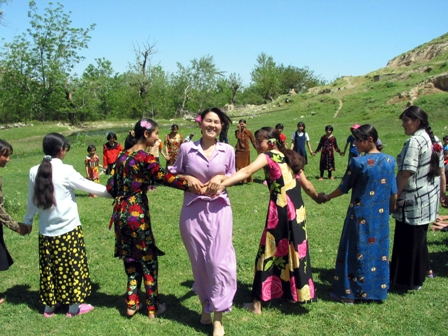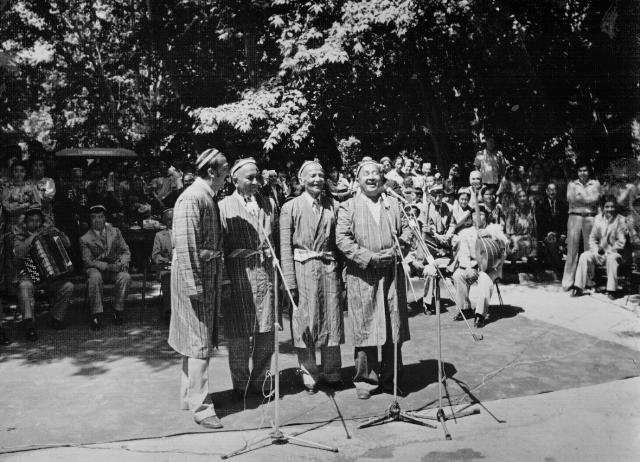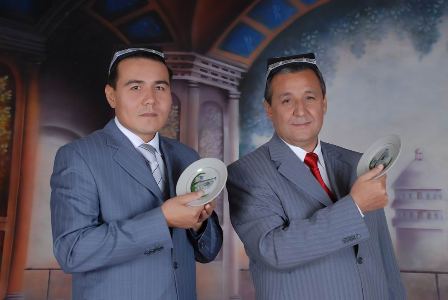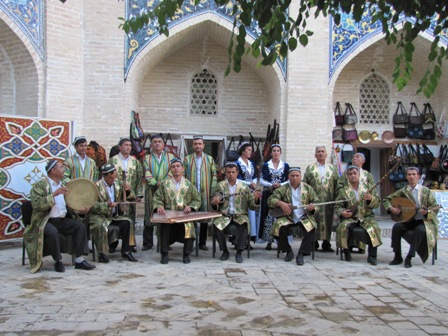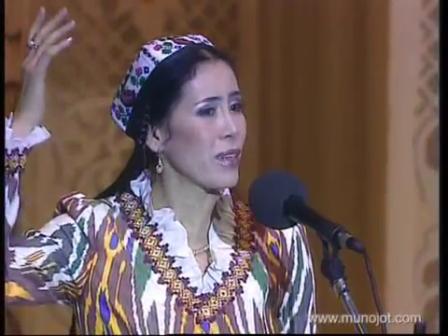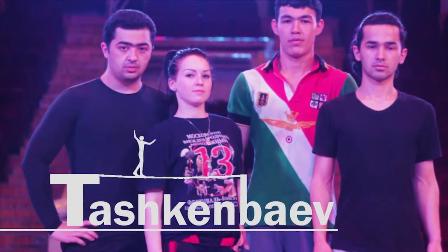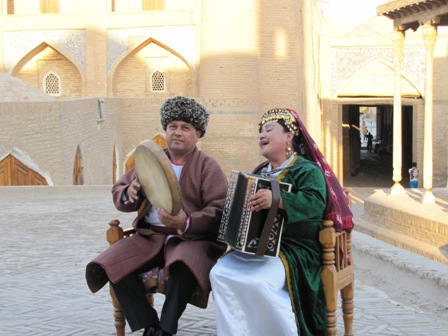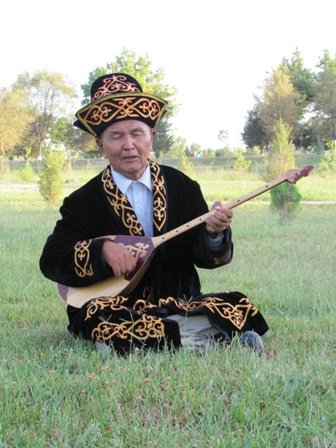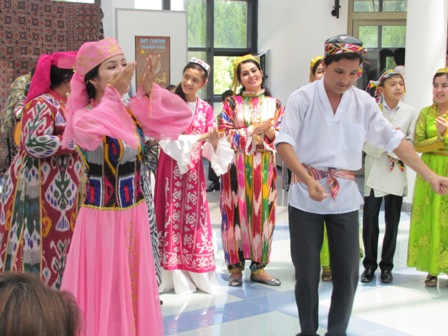Mumtoz Ashula and Yalla
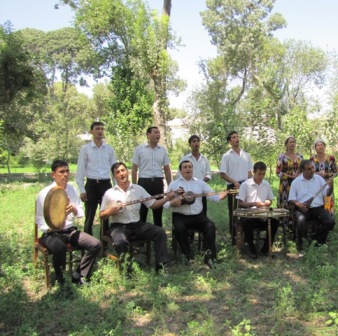
Domain: Performing Arts
Index Number: 02.03.04
Developed song genres are widespread in Uzbek vocal art. At the same time, they are diverse in terms content, structure and melos. Typical for them is peculiar manner of singing. For example, they are more lengthy and lyrical, have songful-cantilena intoning and articulation.
In addition, it is possible to observe in them a step-by-step coverage of the whole range, a close interplay between words and melos, usage of traditional singing style, existence of emotionality and culminations (audj), of solo manner of interpretation with original instrumental accompaniment (i.e. singers accompany themselves by playing on tanbur, dutar or tor). Major developed song genres are represented by mumtoz ashula (i.e. classic ashula) and mumtoz yalla (classic yalla).
Mumtoz ashula is a lengthy-lyrical song genre, which emerged as a result of oral-professional creativity. Main themes, which are covered by this genre, are related to love, philosophy and didactics. In mumtoz ashula usually poems of oriental poetry classics are used, which are written based on aruz versification system. Typical features of this genre are the following: solo manner of singing with instrumental accompaniment; a developed songful melody, in which it is possible to observe the use of singing ornamentation and chants; an open-ended couplet form with culmination (audj), which is sung in high register; existence of diverse techniques of interpretation. The very nature of lyrical songs presupposes individual expression of feelings, i.e. lone conversation with a beloved one or with God. Hereof it is possible to observe a high and elevated tone in poetic text and melodic beauty of chants, which are based on the laws and traditions of oriental singing art, in which maximum effect is achieved by minimal measures (i.e. only thanks to musicality and skill of the performer). It bears mentioning that in mumtoz ashula one can observe a genre variety. For example, in Bukhara there is khalq ashula and mukhammas, in Ferghana Valley – ashula, katta ashula, yovvoyi ashula, in Khoresm – suvora and naqsh. There is also the type of ashula, which has religious and didactic content (such as "munojot", "nat", "qalandar", "khonaqoi", "hamd", "manzuma", etc.).
Mumtoz ashula occupies significant place in traditional music and bastakor's (composer's) creativity. In particular, "Adolat tanovari", "Munojot", "Girya", "Adashkanman", "Yolghiz", "Qomating", "Qurd", "Ol khabar" are to be found in ashula genre. In addition, vocal pieces in ashula genre created by Uzbek bastakors, such as "Kuygan" (Y. Rajabiy), "Sensan sevarim" (О. Khotamov), "Naylayin" (J. Sultanov), "Ey, chehrasi tobonim" (F. Sodiqov), "Diyorimsan" (К. Jabborov), "Bir ishva bilan" (М. Murtazaev), "Guluzorim" and "Qurbon ulam" (А. Abdurasulov), "Qachon bolghay" (М. Mirzaev), occupy significant place in the repertoires of Uzbek singers.
In performance art also the cycles in genre of ashula became widespread. The examples include "Tanovar I –V", "Qalandar I –V", "Eshvoy-Eshvoy qurd-Eshvoy turkman", "Qalandari-Samandari", "Dilkhiroj-Sinakhiroj", etc.
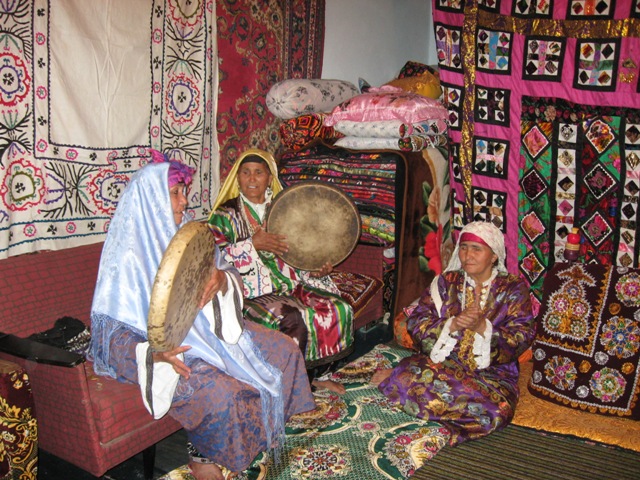 Yalla is a song-dance genre of Uzbek oral art, which is widespread in Uzbekistan. The majority of songs in this genre are associated with love-related themes and lyrics. The poems are based on those, which were created by oriental classics and contemporary Uzbek poets. The manner of singing is solo with instrumental accompaniment. Melodies of yalla are more developed and songful, joyful and dance-suited. If looked from the perspective of music and poetic content, then traditional folklore and contemporary music layers (which unite intonation-melodic means of lyrical song, in which, as a rule, intonation-rhythmic development inertia is preserved) are typical for mumtoz yalla.
Yalla is a song-dance genre of Uzbek oral art, which is widespread in Uzbekistan. The majority of songs in this genre are associated with love-related themes and lyrics. The poems are based on those, which were created by oriental classics and contemporary Uzbek poets. The manner of singing is solo with instrumental accompaniment. Melodies of yalla are more developed and songful, joyful and dance-suited. If looked from the perspective of music and poetic content, then traditional folklore and contemporary music layers (which unite intonation-melodic means of lyrical song, in which, as a rule, intonation-rhythmic development inertia is preserved) are typical for mumtoz yalla.
Mumtoz yalla differs significantly from widely-spread folklore songs in yalla genre (which use folk poetry and solo-group manner of singing with accompaniment of doira or dutar). In mumtoz yalla a soloist sings the solo part, while refrain is sung by a vocal group in unison. Usage of more dance-suited and movement-calling usuls (rhythms) make the song more emotional (among the people "yalla" means "singing with a dance"). The examples include "Yallama yorim", "Kho-kho yalla", "Qizgina", etc. In addition, existence a wavelike intonation and melody, gradual movement to culmination by continuous aggravation, emphasis on verbal intonation and acceleration of usul (rhythm) – these are all characteristic features of mumtoz yalla songs. Moreover, couplet and through-composed couplet forms, which are typical for Uzbek songs, in mumtoz ashula acquire somewhat individual features and get enriched with new versions. This is associated, on the one hand, with its deeply-embedded national roots (which are to be found in ancient ritual-related folklore). On the other hand, this is associated with oral-professional singing practice, for which typical is distinct manner of interpretation.
Development of classic poetry and traditional singing culture brought to formation of yalla and ashula, in which all means of music expression are used. In general, yalla genre occupied significant place in the repertoires of famous singers of Uzbekistan, such as Mamurjon Uzoqov, Tavakkal Qodirov, and others, who acted also as popularizers and promoters of this genre among people. The brightest examples of yalla include: "Qalam qoshliging" (or "Jonon bolaman") and "Mustakhzod" (by М. Kharratov), "Doghman", "Surating", "Parvo etib ket", "Yakka bu Farghonada" and "Kozlaring" (by М. Mirzaev), etc.
Notably, women-yallachi (performers of yalla songs) sang cycles of yalla with doira (Katta yalla and Kichik yalla) during family-related festivities in Namangan. Also, in performance practice such cycles of ashula and yalla as "Yor istab" (ashula) and "Mustakhzod" (yalla), "Farghona ruboisi", etc., became widespread.
At present, yalla is being introduced and interpreted in a contemporary sense in variety art.





